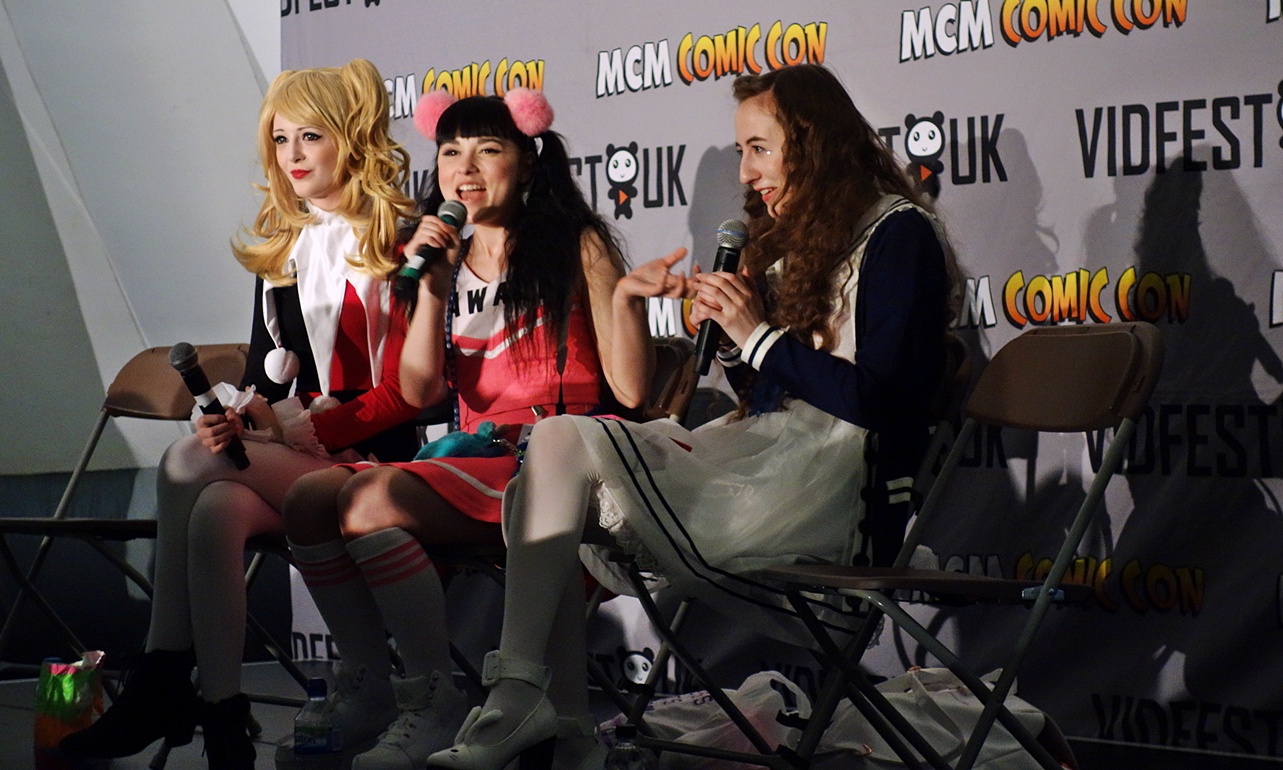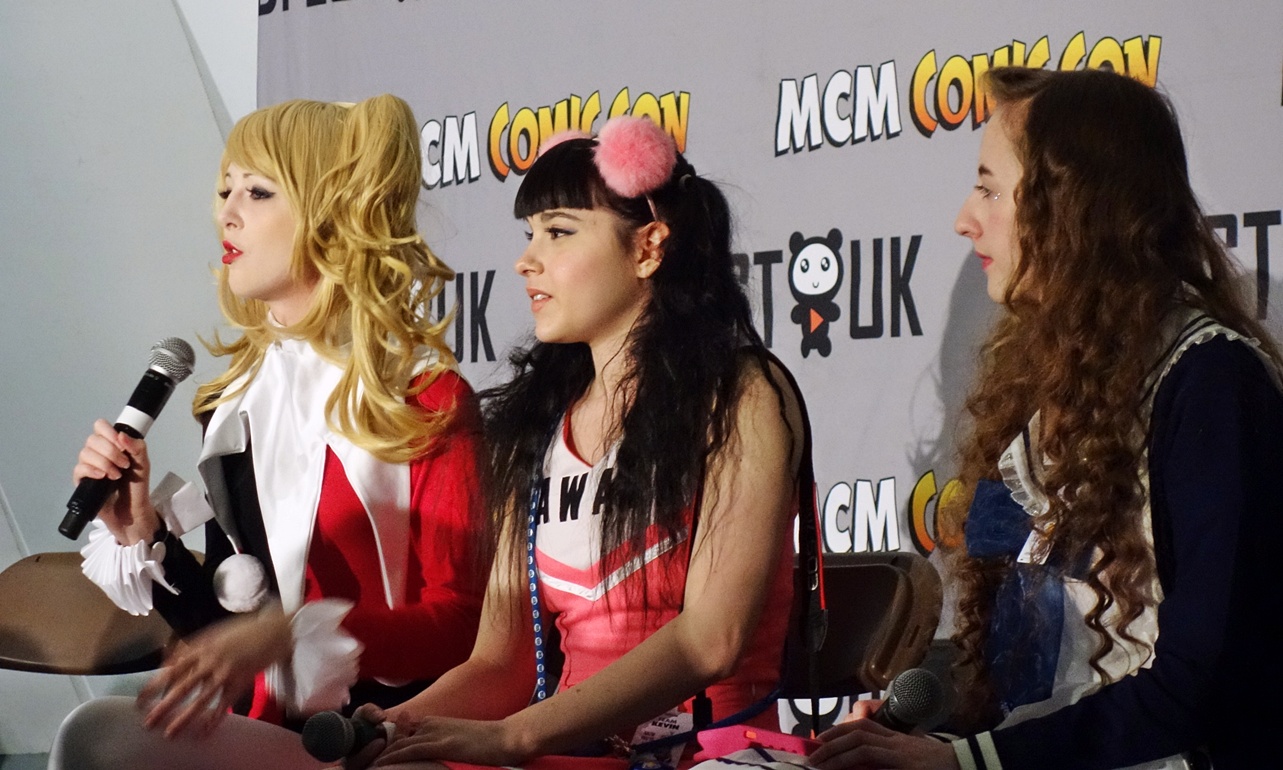The VidFest stage at MCM London Comic Con saw a J-pop culture on YouTube panel, which included Beckii Cruel, Noodlerella (who also had with her a bag of Candy King sweets) and Kelsey Ellison. Abi Mills was also set to be a part of the panel, but had another commitment.
The three began by introducing themselves. Beckii has been on YouTube for seven years and rose to popularity after uploading dance covers to Japanese pop music, which went viral in Japan. This, in turn, resulted in her travelling to Japan. “Recently I’ve been doing more fashion content, but there’s always that Japanese element to what I do,” said Beckii.
“I have a YouTube [channel] as well, that was actually inspired by Beckii,” laughed Kelsey, as she explained how she also decided to join in and upload dance covers to J-pop. April 2014 saw her release her own J-pop inspired single, POM POM.
“I’m a cosplayer and a vlogger,” said Noodlerella, who also uploads Japanese pop culture-related content. Her channel includes cosplay and fashion tutorials as well as character impressions.
The trio went on to explain ways in which their YouTube channels include Japanese culture. Beckii explained that her channel “used to be more about music and dance, but now it’s more about fashion.”
“I still do dance covers,” said Kelsey. “I’m still quite orientated around music, because I love music.” Being inspired by Japanese fashion, particularly Harajuku, she also uploads videos on this too. “I do random vlogs as well,” she added.
Noodlerella noted that she was initially like “a shy weeaboo” and really embarrassed talking about her interests to anyone. “The internet was kind of my way of expressing it. Making videos about anime now is just… that’s what I do, and it’s great that other people have been introduced to it through my channel.”
The panel then moved to their audience demographic. Beckii mentioned that when she started and her videos went viral, she noticed that her main demographic was Japanese men in their 30s and 40s. She mentioned how in Japanese culture a lot of idol fans tend to be middle-aged men. “It’s a little bit strange at first,” she said. “But it’s a really big part of idol culture and otaku culture. It surprised me to learn about that.”
 “It’s a very different culture in the East,” added Kelsey. “It’s just what happens, and you kind of have to roll with it. Just be careful obviously.” Kelsey highlighted that currently, the majority of the people that watch her videos are in the UK, followed by Japan and the US.
“It’s a very different culture in the East,” added Kelsey. “It’s just what happens, and you kind of have to roll with it. Just be careful obviously.” Kelsey highlighted that currently, the majority of the people that watch her videos are in the UK, followed by Japan and the US.
Beckii then mentioned that one of the reasons behind this demographic was Japan’s ageing population, with a lot more older people than there are young people. “There’s a lot of Japanese men who are not married, or they’re dedicated to their work, they have a lot of disposable income and they decide to spend on their favourite idols.
“Through my success in Japan, there was a documentary about me on BBC3 in 2010,” said Beckii, highlighting the Schoolgirl Superstar at 14 documentary that was broadcast. “That actually introduced a lot of Western fans to my content – a lot of young girls who were maybe in the same stage as me that wanted to do Japanese pop dancing on YouTube, or fans of manga and anime.” At this point, Kelsey raised her hand, as if to signify that she was one of those fans.
Noodlerella mentioned that the Japanese audience on her channel is actually very small. “I feel like I have an inescapable Western look,” she said, feeling that this is probably the reason why. She revealed that she has more of a Western audience interested in Japanese pop culture. “My audience is 13 to 20-year-olds mostly, it’s quite a good mix of boys and girls. Sometimes, if I do get older men watching, [they leave] comments where you just know it’s not a girl, like ‘Love this, so super cute.’ It just doesn’t match.”
Beckii then highlighted tips on how YouTubers could expand their Japanese audience. “My videos, while they were always put on YouTube, the way that I went viral, somebody uploaded one of my videos to Nico Nico Douga, which is a Japanese video-sharing website.” She highlighted the culture of dance videos on Nico Nico Douga, and when her video was uploaded people were interested in seeing a Western girl performing on the Japanese site. “As you become fluent in Japanese live-streaming, it’s instant feedback from people.”
“Twitter’s also really huge in Japan,” said Kelsey. “If you want an audience in Japan, you do have to learn Japanese.” She added how she had learnt a lot from just tweeting in Japanese. From her experience on Nico Nico Douga, she mentioned how the Japanese audience is very welcoming. “Putting Japanese tags in YouTube videos helped me a lot, especially when I was doing dance covers.”
“Japanese people really love seeing Western peoples take on Japanese culture,” said Noodlerella. Kelsey and Beckii nodded in agreement. “Seeing you do a Japanese song or vlogging about Japan, they love seeing how Western people view it.”
Kelsey elaborated, saying how her vlogs during her time in Japan have been more popular than any of her other vlogs, citing how “English, American and European people want to see what Japan is like. But also Japanese people are watching to see this strange girl in Japan.”
Comparing Japanese youth culture with that in the West, Beckii highlighted how one could feel pressured by the Western “sexy and grown-up” style. “When I realised that there was another way to be cute and desirable I was really pleased to find that and that’s been something which I’ve kept with me when growing up. It’s really nice to have a different take on culture and what’s desirable as well.”
“When I was in high school, everyone looked really grown up, and I still looked about eight years old,” laughed Kelsey, adding that even now, if she tries to dress mature, she just looks like she’s wearing her mother’s clothes. “The cute style just fits me so much better and people always compliment [me] on it…it’s really nice to be able to dress how you want, which is what I really like about Japan and Japanese fashion. I feel like that’s missing here in England.”
 They noted how it’s a style that can make them look younger (“I got asked if I was 15 today,” said Kelsey), but this can also have its downsides.
They noted how it’s a style that can make them look younger (“I got asked if I was 15 today,” said Kelsey), but this can also have its downsides.
“I was in Dealz once and I was trying to buy some eyelashes,” said Beckii. “They wouldn’t sell them to me because they didn’t think I was old enough.”
“Eyelashes?” asked Noodlerella.
“I always get ID’ed for eyelashes,” said Kelsey.
“WHAT?” responded Noodlerella.
A question from an attendee raised how a lot of the appeal of an alternative aesthetic in Japanese culture tended to be based around females, and so they asked if a similar effect could be found amongst male aesthetics and male demographic in Japanese culture.
“I think there’s a gap for it,” responded Kelsey.
“I especially think that Western culture’s fashion for boys is incredibly limited,” said Noodlerella. “It’s so boring. I would love to see guys, especially on YouTube, doing this thing that I see so many girls do, incorporating Japanese culture.”
“I’ve personally noticed that in Japan there’s more leniency for gender expression,” said Beckii. “I don’t think there’s too much limitation in Japan when it comes to gender and fashionable expression.”
With that the panel came to a close, but not before Kelsey let the audience know about her YouTube channel, and that she hates the name KimonoTime.
Originally published on MCM Buzz on 23 May 2015.



